INDESIT EWDE 71280 W EU User Manual

Instructions for use
WASHER-DRYER
GB |
|
ES |
|
CZ |
|
|
|
|
|
|
|
English,1 |
Español,13 |
Česky,25 |
|||
|
|
|
|
|
|
SK |
|
BG |
|
UA |
|
|
|
|
|
|
|
Slovensky,37 |
Български,49 |
Українська,61 |
|||
|
|
|
|
|
|
SR |
|
|
|
|
|
|
|
|
|
|
|
Cрпски,73 |
|
|
|
|
|
EWDE 71280
! This symbol reminds you to read this instruction
manual. |
GB |
|
Contents
Installation, 2-3
Unpacking and levelling
Connecting the electricity and water supplies
The first wash cycle
Technical data
Care and maintenance, 4
Cutting off the water or electricity supply
Cleaning the Washer-dryer
Cleaning the detergent dispenser drawer
Caring for the door and drum of your appliance
Cleaning the pump
Checking the water inlet hose
Precautions and tips, 5
General safety
Disposal
Description of the Washer-dryer, 6-7
Control panel
Display
How to run a wash cycle or a drying cycle, 8
Wash cycles and options, 9
Table of wash cycles Wash options
Detergents and laundry, 10
Detergent dispenser drawer
Preparing the laundry
Fast daily cycles
Special wash cycles
Load balancing system
Troubleshooting, 11
Service, 12
1
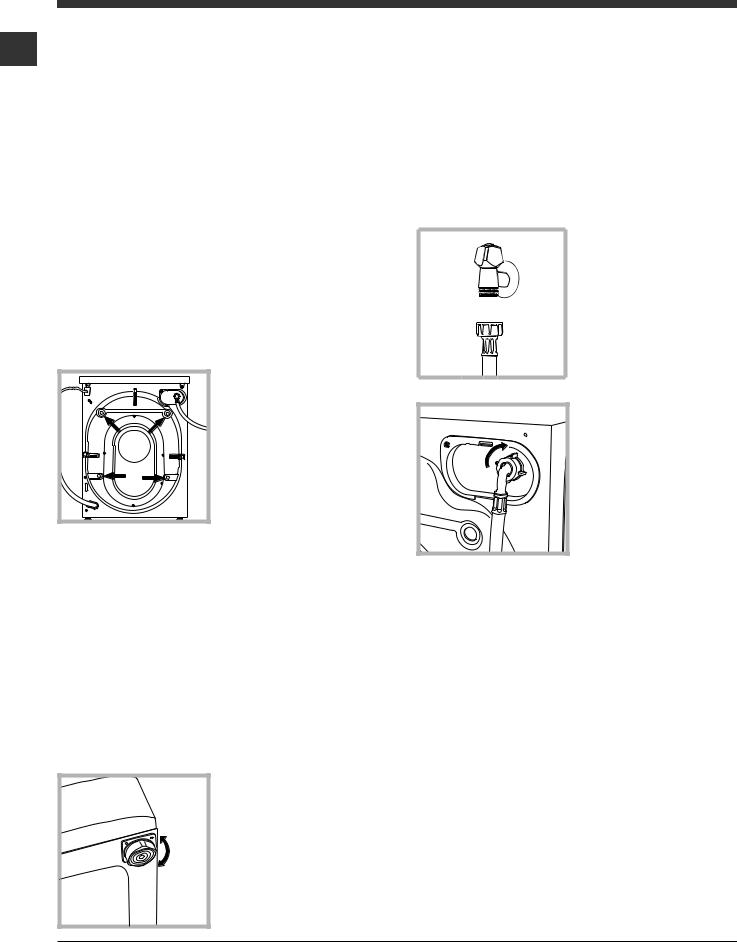
Installation
! This instruction manual should be kept in a safe GB place for future reference. If the washing machine is sold, transferred or moved, make sure that the instruction manual remains with the machine so that the new owner is able to familiarise himself/
herself with its operation and features.
! Read these instructions carefully: they contain vital information relating to the safe installation and operation of the appliance.
Unpacking and levelling
Unpacking
1.Remove the washing machine from its packaging.
2.Make sure that the washing machine has not been damaged during the transportation process. If it has been damaged, contact the retailer and do not proceed any further with the installation process.
3. Remove the 4 protective screws (used during transportation) and the rubber washer with the corresponding spacer, located on the rear part of the appliance (see figure).
4.Close off the holes using the plastic plugs provided.
5.Keep all the parts in a safe place: you will need them again if the washing machine needs to be moved to another location.
! Packaging materials should not be used as toys for children.
Levelling
1. Install the washing machine on a flat sturdy floor, without resting it up against walls, furniture cabinets or anything else.
2. If the floor is not perfectly level, compensate for any unevenness by tightening or loosening the adjustable front feet (see figure); the angle of inclination, measured in relation to the worktop, must not exceed 2°.
Levelling the machine correctly will provide it with stability, help to avoid vibrations and excessive noise and prevent it from shifting while it is operating. If it is placed on carpet or a rug, adjust the feet in such a way as to allow a sufficient ventilation space underneath the washing machine.
Connecting the electricity and water supplies
Connecting the water inlet hose
1. Connect the supply pipe by screwing it to a cold water tap using a ¾ gas threaded connection (see figure).
Before performing the connection, allow the water to run freely until it is perfectly clear.
2. Connect the inlet hose to the washing machine by screwing it onto the corresponding water inlet of the appliance, which is situated on the top righthand side of the rear part of the appliance
(see figure).
3. Make sure that the hose is not folded over or bent.
! The water pressure at the tap must fall within the values indicated in the Technical details table
(see next page).
!If the inlet hose is not long enough, contact a specialised shop or an authorised technician.
!Never use second-hand hoses.
!Use the ones supplied with the machine.
2
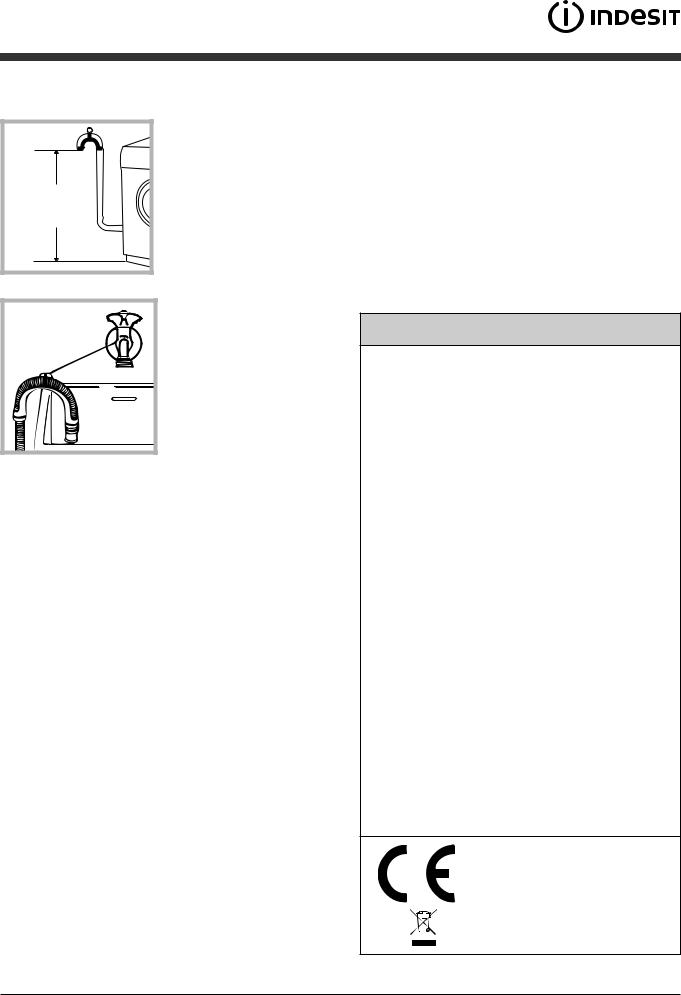
Connecting the drain hose
65 - 100 cm |
Connect the drain hose, without bending it, to a drainage duct or a wall drain located at a height between 65 and 100 cm from the floor;
alternatively, rest it on the side of a washbasin or bathtub, fastening the duct supplied to the tap (see figure). The free end of the hose should not be underwater.
! We advise against the use of hose extensions; if it is absolutely necessary, the extension must have the same diameter as the original hose and must not exceed 150 cm in length.
Electrical connections
Before plugging the appliance into the electricity socket, make sure that:
•the socket is earthed and complies with all applicable laws;
•the socket is able to withstand the maximum power load of the appliance as indicated in the Technical data table (see opposite);
•the power supply voltage falls within the values indicated in the Technical data table (see opposite);
•the socket is compatible with the plug of the washing machine. If this is not the case, replace the socket or the plug.
!The washing machine must not be installed outdoors, even in covered areas. It is extremely dangerous to leave the appliance exposed to rain, storms and other weather conditions.
!When the washing machine has been installed, the electricity socket must be within easy reach.
! Do not use extension cords or multiple sockets. |
|
|
GB |
||
! The cable should not be bent or compressed. |
||
|
||
|
||
! The power supply cable must only be replaced |
|
|
by authorised technicians. |
|
|
Warning! The company shall not be held responsible |
|
|
in the event that these regulations are not respected. |
|
|
The first wash cycle |
|
|
Once the appliance has been installed, and before |
|
|
you use it for the first time, run a wash cycle with |
|
|
detergent and no laundry, using the wash cycle |
|
|
“Auto Clean” (see “Cleaning the washer-dryer”). |
|
Technical data
Model |
EWDE 71280 |
|
|
|
|
|
width 59,5 cm |
|
Dimensions |
height 85 cm |
|
|
depth 53,5 cm |
|
|
from 1 to 7 kg for the wash |
|
Capacity |
programme; |
|
from 1 to 5 kg for the drying |
||
|
||
|
programme |
|
|
|
|
Electrical |
please refer to the technical |
|
connections |
data plate fixed to the machine |
|
|
|
|
|
maximum pressure 1 MPa |
|
Water con- |
(10 bar) |
|
minimum pressure 0.05 MPa |
||
nection |
||
(0.5 bar) |
||
|
||
|
drum capacity 58 litres |
|
Spin speed |
up to 1200 rotations per minute |
|
|
|
|
|
Wash: programme 10; tem- |
|
|
perature 60°C; using a load |
|
Energy rated |
of 7 kg. |
|
programmes |
Drying: select the 10 wash |
|
according to |
programme and set the |
|
regulations |
drying level to “A4”, for both |
|
EN 50229 |
loads. The first drying cycle |
|
|
must be carried out with the |
|
|
nominal load. |
This appliance conforms to the following EC Directives:
-EMC 2014/30/EU (Electromagnetic Compatibility)
-2012/19/EU - (WEEE)
- LVD 2014/35/EU Low Voltage)
3
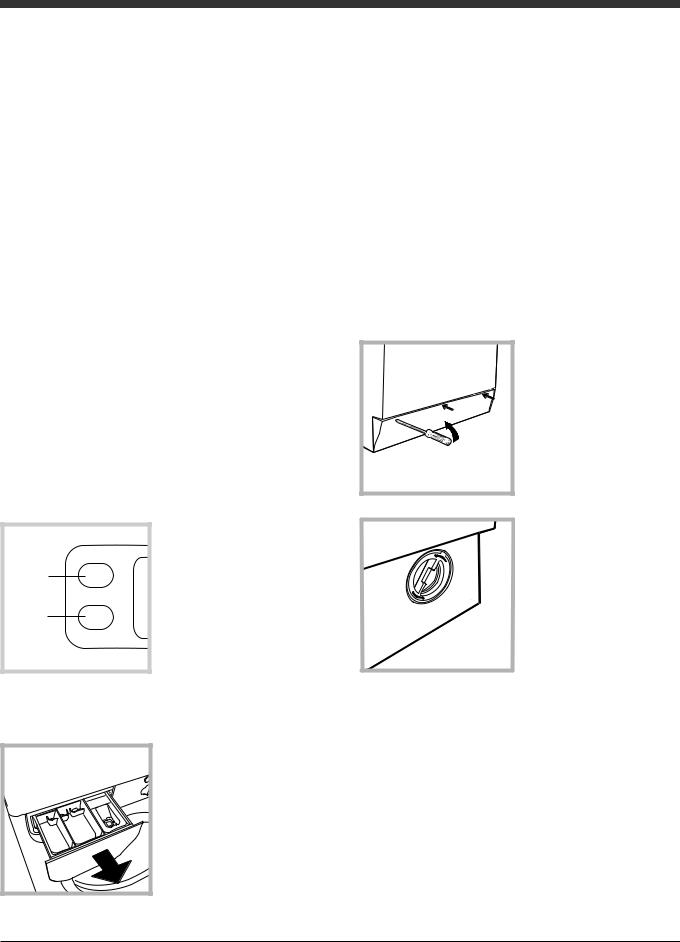
Care and maintenance
|
Cutting off the water and electricity |
|
GB |
||
supplies |
||
|
||
|
• Turn off the water tap after every wash cycle. |
|
|
This will limit wear on the hydraulic system inside |
|
|
the Washer-dryer and help to prevent leaks. |
|
|
• Unplug the Washer-dryer when cleaning it and |
|
|
during all maintenance work. |
|
|
Cleaning the Washer-dryer |
•The outer parts and rubber components of the appliance can be cleaned using a soft cloth soaked in lukewarm soapy water. Do not use solvents or abrasives.
•The washer-dryer has a “Auto Clean” programme for its internal parts that must be run with
no load in the drum.
For maximum performance you may want to use either the detergent (i.e. a quantity 10% the quantity specified for lightly-soiled garments) or special additives to clean the washer-dryer. We recommend running a cleaning programme every 40 wash cycles.
To start the programme press buttons A and B simultaneously for 5 seconds (see figure).
The programme will start automatically and will last approximately 70 minutes.
A
B
Cleaning the detergent dispenser drawer
Remove the dispenser by raising it and pulling it out (see figure).
Wash it under running water; this operation should be repeated frequently.
Caring for the door and drum of your appliance
•Always leave the porthole door ajar in order to prevent unpleasant odours from forming.
Cleaning the pump
The Washer-dryer is fitted with a self-cleaning pump which does not require any maintenance. Sometimes, small items (such as coins or buttons) may fall into the pre-chamber which protects the pump, situated in its bottom part.
! Make sure the wash cycle has finished and unplug the appliance.
To access the pre-chamber:
1. using a screwdriver, remove the cover panel on the lower front part of the Washerdryer (see figure);
2. unscrew the lid by rotating it anti-clockwi- se (see figure): a little water may trickle out. This is perfectly normal;
3.clean the inside thoroughly;
4.screw the lid back on;
5.reposition the panel, making sure the hooks are securely in place before you push it onto the appliance.
Checking the water inlet hose
Check the inlet hose at least once a year. If there are any cracks, it should be replaced immediately: during the wash cycles, water pressure is very strong and a cracked hose could easily split open.
! Never use second-hand hoses.
4

Precautions and tips
! This Washer-dryer was designed and constructed in accordance with international safety regulations. The following information is provided for safety reasons and must therefore be read carefully.
General safety
•This appliance can be used by children aged from 8 years and above and persons with reduced physical, sensory or mental capabilities or lack of experience and knowledge if they have been given supervision or instruction concerning use of the appliance in a safe way and understand the hazards involved. Children shall not play with the appliance. Cleaning and user maintenance shall not be made by children without supervision.
-Do not dry unwashed items in the tumble dryer.
-Items that have been soiled with substances such as cooking oil, acetone, alcohol, petrol, kerosene, spot removers, turpentine, waxes and wax removers should be washed in hot water with an extra amount of detergent before being dried in the tumble dryer.
-Items such as foam rubber (latex foam), shower caps, waterproof textiles, rubber backed articles and clothes or pillows fitted with foam rubber pads should not be dried in the tumble dryer.
-Fabric softeners, or similar products, should be used as specified by the fabric softener instructions.
-The final part of a tumble dryer cycle occurs without heat (cool down cycle) to ensure that the items are left at a temperature that ensures that the items will not be damaged.
WARNING: Never stop a tumble dryer before the end of the drying cycle unless all items are quickly removed and spread out so that the heat is dissipated.
•This appliance was designed for domestic use only.
•Do not touch the machine when barefoot or with wet or damp hands or feet.
•Do not pull on the power supply cable when unplugging the appliance from the electricity socket. Hold the plug and pull.
•Do not open the detergent dispenser drawer while the machine is in operation.
•Do not touch the drained water as it may reach extremely high temperatures.
•Neverforcetheportholedoor.Thiscoulddamagethesafety lock mechanism designed to prevent accidental opening.
•If the appliance breaks down, do not under any circumstances access the internal mechanisms in an attempt to repair it yourself.
•Always keep children well away from the appliance while it is operating.
•The door can become quite hot during the wash cycle.
• If the appliance has to be moved, work in a group of two |
GB |
or three people and handle it with the utmost care. Never |
try to do this alone, because the appliance is very heavy.
•Before loading laundry into the Washer-dryer, make sure the drum is empty.
•During the drying phase, the door tends to get quite hot.
•Do not use the appliance to dry clothes that
have been washed with flammable solvents (e.g. trichlorethylene).
•Do not use the appliance to dry foam rubber or similar elastomers.
•Make sure that the water tap is turned on during the drying
cycles.
•Children of less than 3 years should be kept away from the appliance unless continuously supervised.
•Remove all objects from pockets such as lighters and matches.
Disposal
•Disposing of the packaging materials: observe local regulations so that the packaging may be re-used.
•The European Directive 2012/19/EU (WEEE) on Waste
Electrical and Electronic Equipment, requires that old household electrical appliances must not be disposed of in the normal unsorted municipal waste stream. Old appliances must be collected separately in order to optimise the recovery and recycling of the materials they contain and reduce the impact on human health and the environment. The crossed out “wheeled bin” symbol on the product reminds you of your obligation, that when you dispose of the appliance it must be separately collected. Consumers should contact their local authority or retailer for information concerning the correct disposal of their old appliance.
5
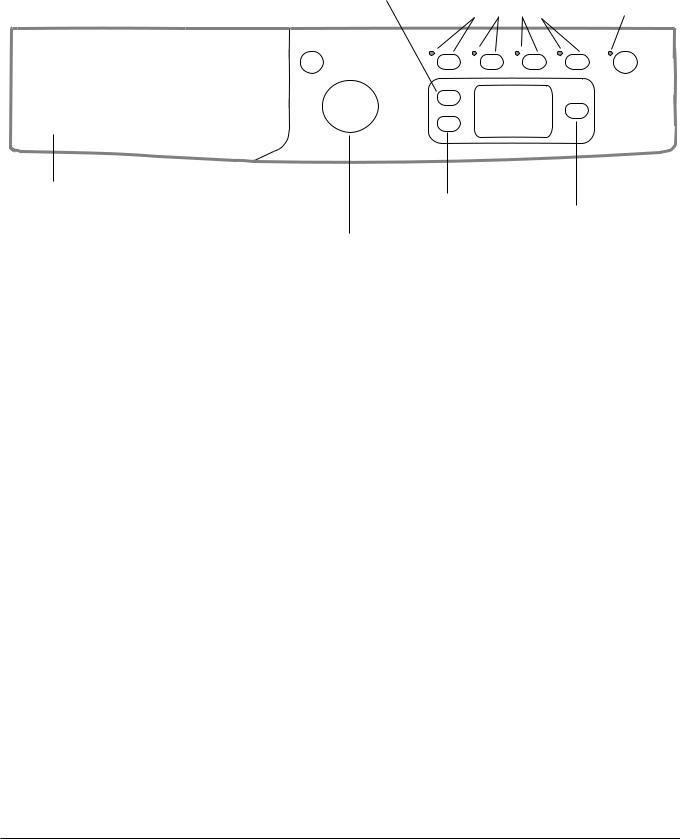
Description of the Washer-dryer
|
|
|
|
|
|
Control panel |
|
GB |
|||
|
|
||
|
|
|
ON/OFF |
|
TEMPERATURE |
OPTION |
START/PAUSE |
|
|
|||||
|
buttons with |
||||
button |
|
Button |
button with indicator light |
||
|
indicator lights |
||||
|
|
|
|
|
|
|
|
|
|
|
|
|
|
|
|
|
|
DISPLAY
Detergent dispenser drawer
|
SPIN SPEED |
DRYING |
WASH CYCLE |
Button |
|
Button |
|
|
knob |
|
|
Detergent dispenser drawer: used to dispense detergents and washing additives (see “Detergents and laundry”).
ON/OFF button  : press this briefly to switch the machine on or off. The START/PAUSE indicator light, which flashes slowly in a green colour shows that the machine is switched on. To switch off the Washer-dryer during the wash cycle, press and hold the button for approximately 2 seconds; if the button is pressed briefly or accidentally the machine will not switch off. If the machine is switched off during a wash cycle, this wash cycle will be cancelled.
: press this briefly to switch the machine on or off. The START/PAUSE indicator light, which flashes slowly in a green colour shows that the machine is switched on. To switch off the Washer-dryer during the wash cycle, press and hold the button for approximately 2 seconds; if the button is pressed briefly or accidentally the machine will not switch off. If the machine is switched off during a wash cycle, this wash cycle will be cancelled.
WASH CYCLE knob: used to set the desired wash cycle
(see “Table of wash cycles”).
OPTION buttons with indicator light: used to select the available options. The indicator light corresponding to the selected option will remain lit.
SPIN button  : press to reduce or completely exclude the spin cycle - the value is indicated on the display.
: press to reduce or completely exclude the spin cycle - the value is indicated on the display.
TEMPERATURE button  : press to decrease or completely exclude the temperature: the value will be shown on the display.
: press to decrease or completely exclude the temperature: the value will be shown on the display.
DRYING button  : press to decrease or exclude drying; the selected drying level or time will appear on the display
: press to decrease or exclude drying; the selected drying level or time will appear on the display
(see “How to run a wash cycle or a drying cycle”).
START/PAUSE button 
 with indicator light: when the green indicator light flashes slowly, press the button to start a wash cycle. Once the cycle has begun the indicator light will remain lit in a fixed manner. To pause the wash cycle, press the button again; the indicator light will flash in an orange colour. If the symbol
with indicator light: when the green indicator light flashes slowly, press the button to start a wash cycle. Once the cycle has begun the indicator light will remain lit in a fixed manner. To pause the wash cycle, press the button again; the indicator light will flash in an orange colour. If the symbol  is not illuminated, the door may be opened (wait approximately 3 minutes). To start the wash cycle from the point at which it was interrupted, press the button again.
is not illuminated, the door may be opened (wait approximately 3 minutes). To start the wash cycle from the point at which it was interrupted, press the button again.
Standby mode
This Washer-dryer, in compliance with new energy saving regulations, is fitted with an automatic standby system which is enabled after a few minutes if no activity is detected. Press the ON-OFF button briefly and wait for the machine to start up again.
Consumption in off-mode: 0,5 W Consumption in Left-on: 8 W
6
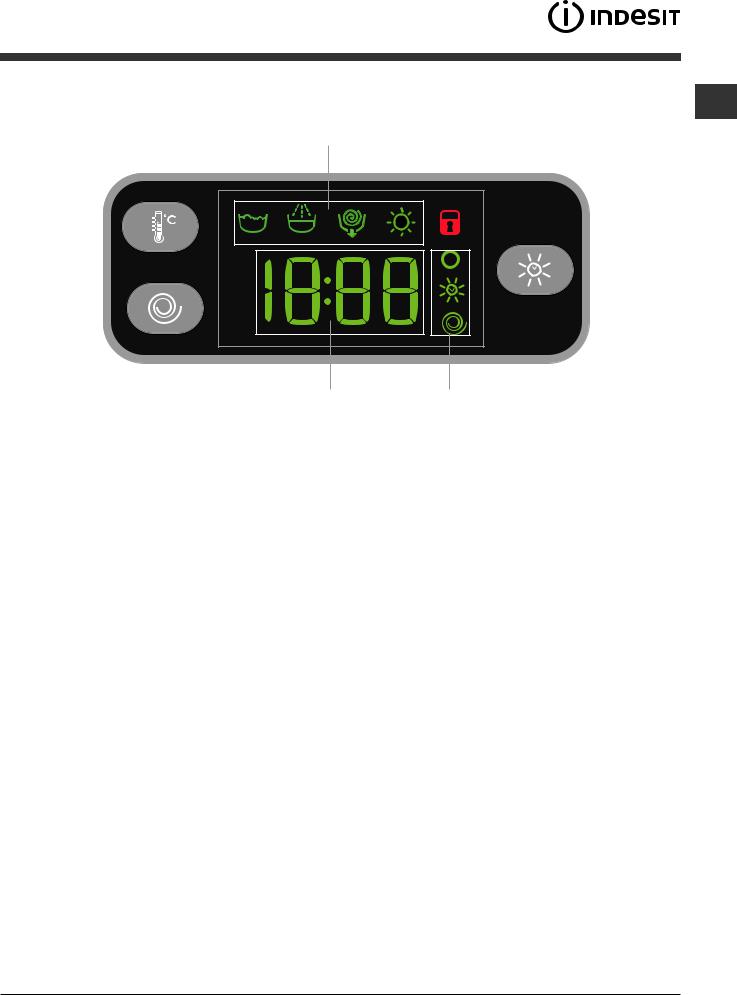
Display |
GB |
|
B
A C
The display is useful when programming the machine and provides a great deal of information.
The duration of the available programmes and the remaining time of a running cycle appear in section A; if the DELAY START option has been set, the countdown to the start of the selected programme will appear. Furthermore, pressing the corresponding button allows you to view the maximum temperature, spin speed and drying level or time values attained by the machine during the selected cycle.
The phases scheduled for the selected cycle and, once the cycle has begun, the current phase of the wash cycle (and drying
cycle, if applicable) appear in section B.
 Wash
Wash
 Rinse
Rinse

 Spin / Drain
Spin / Drain
 Drying
Drying
The icons corresponding to “temperature”  , “Drying”
, “Drying”  and “spin”
and “spin”  appear in section C from top to bottom: If the
appear in section C from top to bottom: If the  symbol lights up, the display will visualise the set “temperature” value.
symbol lights up, the display will visualise the set “temperature” value.
The  symbol lights up while the drying settings are being adjusted. If the
symbol lights up while the drying settings are being adjusted. If the  symbol lights up, the display will visualise the set “spin” value.
symbol lights up, the display will visualise the set “spin” value.
Door locked symbol 
The lit symbol indicates that the door is locked. To prevent any damage, wait until the symbol turns off before opening the
door (wait approximately 3 minutes).
To open the door while a cycle is in progress, press the START/PAUSE button; if the DOOR LOCKED  symbol is switched off the door may be opened (wait approximately 3 minutes).
symbol is switched off the door may be opened (wait approximately 3 minutes).
7

How to run a wash cycle or a drying cycle
1. SWITCH THE MACHINE ON. Press the  button; the GB START/PAUSE indicator light will flash slowly in a green
button; the GB START/PAUSE indicator light will flash slowly in a green
colour.
2.LOAD THE LAUNDRY. Open the porthole door. Load the laundry, making sure you do not exceed the maximum load value indicated in the table of programmes on the following page.
3.MEASURE OUT THE DETERGENT. Pull out the detergent dispenser drawer and pour the detergent into the relevant compartments as described in “Detergents and laundry”.
4.CLOSE THE DOOR.
5.SELECT THE WASH CYCLE. Set the WASH CYCLE knob to the desired programme; a temperature and spin speed is set for each wash cycle; these may be adjusted. The duration of the cycle will appear on the display.
6.CUSTOMISE THE WASH CYCLE. Use the relevant buttons:
Modifying the temperature and/or spin speed. The machine automatically displays the maximum temperature and spin speed values set for the selected cycle, or the most recently-used settings if they are compatible with the selected cycle. The temperature can be decreased by pressing the button, until the cold wash “OFF” setting is reached. The spin speed may be progressively reduced by pressing the  button, until it is completely excluded (the “OFF” setting). If these buttons are pressed again, the maximum values are restored.
button, until it is completely excluded (the “OFF” setting). If these buttons are pressed again, the maximum values are restored.
! Exception: if the 2 programme is selected, the temperature can be increased up to a value of 60°C.
 Setting the drying cycle
Setting the drying cycle
The first time the button  is pressed, the machine will automatically select the maximum drying cycle which is compatible with the selected wash cycle. Subsequent presses will decrease the drying level and then the drying time, until the cycle is excluded completely (“OFF”).
is pressed, the machine will automatically select the maximum drying cycle which is compatible with the selected wash cycle. Subsequent presses will decrease the drying level and then the drying time, until the cycle is excluded completely (“OFF”).
Drying may be set as follows:
A- Based on the desired laundry dryness level:
Iron dry: suitable for clothes which will need ironing afterwards. the remaining dampness softens creases, making them easier to remove; “A1” appears on the display. Hanger dry: ideal for clothes which do not need to be dried fully; “A2” appears on the display.
Cupboard dry: suitable for laundry which can be put back in a cupboard without being ironed; “A3” appears on the display. Extra dry: suitable for garments which need to be dried completely, such as sponges and bathrobes; “A4” appears on the display.
B - Based on a set time period: between 30 and 180 minutes.
If your laundry load to be washed and dried is much greater than the maximum stated load (see adjacent table), perform the wash cycle, and when the cycle is complete, divide the garments into groups and put some of them back in the drum.
At this point, follow the instructions provided for a “Drying only” cycle. Repeat this procedure for the remainder of the load.
N.B: a cooling-down period is always added to the end of each drying cycle.
Drying only
Use the cycle selector knob to select a drying cycle (15-16) in accordance with the type of fabric. The desired drying level or time may also be set using the DRYING button  .
.
Modifying the cycle settings.
•Press the button to enable the option; the indicator light corresponding to the button will switch on.
•Press the button again to disable the option; the indicator light will switch off.
!If the selected option is not compatible with the programmed wash cycle, the indicator light will flash and the option will not be activated.
!If the selected option is not compatible with another option which has been selected previously, the indicator light corresponding to the first option selected will flash and only the second option will be activated; the indicator light corresponding to the enabled option will remain lit.
!The options may affect the recommended load value and/or the duration of the cycle.
7.START THE PROGRAMME. Press the START/PAUSE button. The corresponding indicator light will become green, remaining lit in a fixed manner, and the door will
be locked (the DOOR LOCKED symbol  will be on). To change a wash cycle while it is in progress, pause the Washer-dryer using the START/PAUSE button (the START/PAUSE indicator light will flash slowly in an orange colour); then select the desired cycle and press the START/PAUSE button again. To open the door while a cycle is in progress, press the START/PAUSE button;
will be on). To change a wash cycle while it is in progress, pause the Washer-dryer using the START/PAUSE button (the START/PAUSE indicator light will flash slowly in an orange colour); then select the desired cycle and press the START/PAUSE button again. To open the door while a cycle is in progress, press the START/PAUSE button;
if the DOOR LOCKED  symbol is switched off the door may be opened (wait approximately 3 minutes). Press the START/PAUSE button again to restart the wash cycle from the point at which it was interrupted.
symbol is switched off the door may be opened (wait approximately 3 minutes). Press the START/PAUSE button again to restart the wash cycle from the point at which it was interrupted.
8.THE END OF THE WASH CYCLE. This will be indicated by the text “End” on the display; when the DOOR LOCKED
 symbol switches off the door may be opened (wait approximately 3 minutes). Open the door, unload the laundry and switch off the machine.
symbol switches off the door may be opened (wait approximately 3 minutes). Open the door, unload the laundry and switch off the machine.
! If you wish to cancel a cycle which has already begun, press and hold the  button. The cycle will be stopped and the machine will switch off.
button. The cycle will be stopped and the machine will switch off.
8
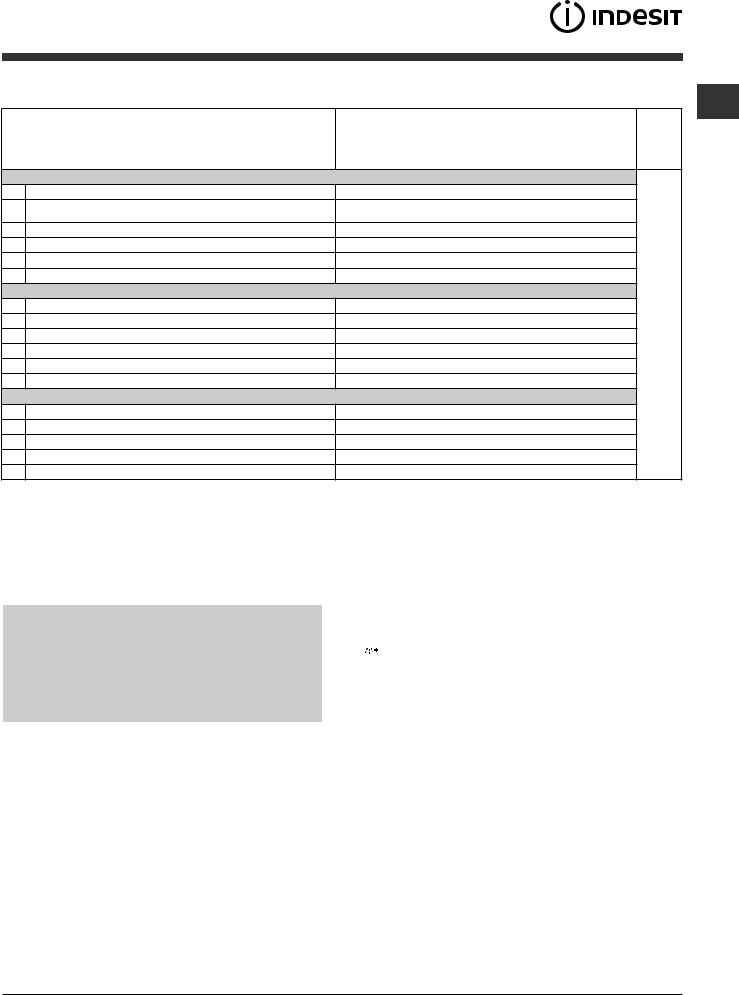
Wash cycles and options
Table of wash cycles |
GB |
|
Wash cycles |
Description of the wash cycle |
|
|
|
|
EVERYDAY FAST
1Colour Mix 59’
2Synthetics 59’
3Cotton 45’
4Wash&Dry 90’
5Wash&Dry 45’
6AirFresh 30’
Special
7Wool: for wool, cashmere, etc.
8Delicate
9Gym Kit
10Eco Cotton 60° (1): heavily soiled whites and resistant colours.
10Eco Cotton 40° (2): lightly soiled whites and delicate colours.
11Cotton: extremely soiled whites.
Partial
12Rinse
13Spin
14Drain
15Cotton dry
16Synthetics dry
Max. |
Max. speed |
|
|
Detergents |
Max. |
||
temp. |
Drying |
|
|
|
|
load |
|
(°C) |
(rpm) |
|
|
Main |
|
Fabric |
(kg) |
|
|
|
|
wash |
|
softener |
|
40° |
|
|
|
|
|
|
|
1000 |
|
|
7 |
||||
40° |
1000 |
|
|
|
|
|
4,5 |
(Max. 60°) |
|
|
|||||
|
|
|
|
|
|
|
|
40° |
1200 |
|
|
|
|
|
3,5 |
30° |
1200 |
|
|
|
|
|
2 |
30° |
1200 |
|
|
|
|
|
1 |
- |
- |
|
|
- |
|
- |
1,5 |
40° |
|
|
|
|
|
|
|
800 |
|
|
2 |
||||
30° |
0 |
|
|
|
|
|
1 |
40° |
600 |
|
|
|
|
|
3,5 |
60° |
1200 |
|
|
|
|
|
7 |
40° |
1200 |
|
|
|
|
|
7 |
90° |
1200 |
|
|
|
|
|
7 |
- |
|
|
|
|
|
|
|
1200 |
|
- |
|
7 |
|||
- |
1200 |
|
|
- |
|
- |
7 |
- |
0 |
- |
|
- |
|
- |
7 |
- |
- |
|
|
- |
|
- |
5 |
- |
- |
|
|
- |
|
- |
4 |
Cycle duration
.display the on checked be can cycles wash the of duration The
The length of cycle shown on the display or in this booklet is an estimation only and is calculated assuming standard working conditions. The actual duration can vary according to factors such as water temperature and pressure, the amount of detergent used, the amount and type of load inserted, load balancing and any wash options selected.
For all Test Institutes:
1)Test wash cycle in compliance with regulations EN 50229: set wash cycle 10 with a temperature of 60°C.
2)Long wash cycle for cottons: set wash cycle 10 with a temperature of 40°C.
Wash options
-If the selected option is not compatible with the programmed wash cycle, the indicator light will flash and the option will not be activated.
-If the selected option is not compatible with another option which has been selected previously, the indicator light corresponding to the first option selected will flash and only the second option will be activated; the indicator light corresponding to the enabled option will remain lit.
ExtraWash 
Enable the Extra Wash  option for very dirty items, where compatible. Press this option to let the cycle automatically re-
option for very dirty items, where compatible. Press this option to let the cycle automatically re-
adjust all wash parameters through a longer lasting cycle. The option always leaves the temperature unchanged, while the spin cycle is automatically brought back to maximum levels. The user
can set the spin cycle back to the desired value at any time.
 Easy Iron
Easy Iron
By selecting this function, the wash and spin cycles will be modified in order to reduce the formation of creases. At the end of the cycle the washing machine will perform slow rotations of the drum; the indicator lights for the EASY IRON and START/PAUSE options will flash (the first one green, the second orange).
To end the cycle, press the START/PAUSE button or the EASY IRON button.
Note: If you also want to run the drying cycle, this option is enabled only if combined with level “A1”(Iron dry).
 Extra rinse
Extra rinse
By selecting this option, the efficiency of the rinse is increased and optimal detergent removal is guaranteed. It is particularly
useful for sensitive skin.
 Delay start
Delay start
To set a delayed start for the selected cycle, press the corresponding button repeatedly until the required delay period has been reached. When this option is enabled, the corresponding indicator light will remain lit. To remove the delayed start setting, press the button until the text “OFF” appears on the display.
9
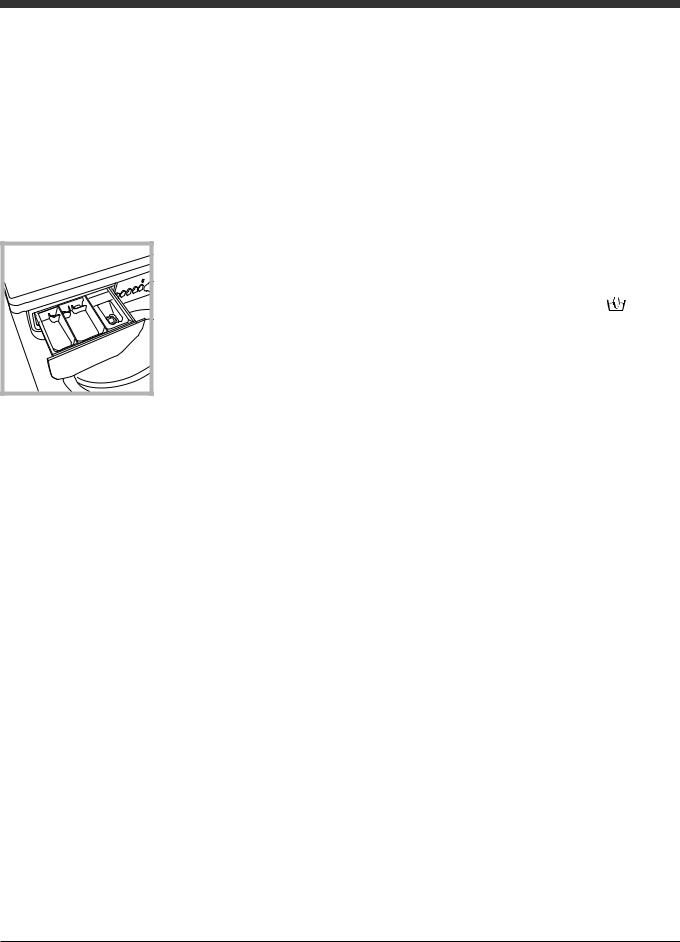
Detergents and laundry
|
Detergent dispenser drawer |
|
GB |
||
|
||
|
Good washing results also depend on the correct dose of |
|
|
||
|
detergent: adding too much detergent will not necessarily |
|
|
result in a more efficient wash, and may in fact cause build |
|
|
up on the inside of your appliance and contribute to envi- |
|
|
ronmental pollution. |
|
|
!Use powder detergent for white cotton garments, for pre- |
|
|
washing, and for washing at temperatures over 60°C. |
|
|
!Follow the instructions given on the detergent packaging. |
|
|
! Do not use hand washing detergents because these |
|
|
create too much foam. |
1 |
2 |
3 |
Open the detergent dispenser drawer and pour in the detergent or washing additive, as follows.
!Do not put the detergent into compartment 1.
!The detergent must be put only in the compartment 2. compartment 2: Detergent for the wash cycle (powder or liquid)
Liquid detergent should only be poured in immediately prior to the start of the wash cycle.
compartment 3: Additives (fabric softeners, etc.)
The fabric softener should not overflow the grid.
Note: If a “tablet detergent” is used, always follow the manufacturer’s instructions.
Preparing the laundry
•Divide the laundry according to:
-the type of fabric/the symbol on the label
-the colours: separate coloured garments from whites.
•Empty all garment pockets and check the buttons.
•Do not exceed the values listed in the “Table of wash cycles”, which refer to the weight of the laundry when dry.
How much does your laundry weigh?
1 sheet 400-500 g
1 pillow case 150-200 g
1 tablecloth 400-500 g
1 bathrobe 900-1200 g
1 towel 150-250 g
Fast daily cycles
A complete set of fast programmes to wash the most commonly used fabrics - even with a full load - and to remove the most frequent daily dirt in less than 1 hour.
Colour Mix 59’: to wash mixed and coloured items together. Synthetics 59’: specific for synthetic items. If the dirt is difficult to remove, the temperature can be increased up to 60° and powder detergent can be used too.
Cotton 45’: short cycle designed to wash delicate cotton items.
Special wash cycles
Wash&Dry 90’: The cycle guarantees the washing and drying performances for a 2 kg load in 90 minutes (level “A1” Iron dry); for larger loads, the cycle’s duration increases in order to guarantee the cycle performances.
Wash&Dry 45’ select programme 5 for washing and drying lightly soiled garments (Cotton and Synthetic) in a short time. This cycle may be used to wash and dry a laundry load of up to 1 kg in just 45 minutes (level “A1” Iron dry). To achieve optimum results, use liquid detergent and pre-treat cuffs, collars and stains.
AirFresh 30’ (programme 6) ideal cycle to refresh garments and remove bad odours, in particular smoke, from cotton and synthetic items in 30’ (max 1.5kg) without the washing phase. Wool: all wool garments can be washed using programme 7, even those carrying the “hand-wash only” label. For best results, use special detergents and do not exceed 2 kg of laundry.
Delicate: use programme 8 to wash very delicate garments. It is advisable to turn the garments inside out before washing them. For best results, use liquid detergent on delicate garments.
To wash Silk garments and Curtains select cycle 8 and then option “EASY IRON”; the machine will end the cycle while the laundry is soaking and the “EASY IRON” indicator light will flash. To drain the water so that the laundry may be removed, press the START/PAUSE button or the “EASY IRON” button. When selecting an exclusively time-based drying function, a drying cycle is performed at the end of the wash cycle that is particularly delicate, thanks to light handling and appropriate temperature control of the water jet.
The recommended durations are:
1 kg of synthetic garments --> 150 min
1 kg of synthetic and cotton garments --> 180 min 1 kg of cotton garments --> 180 min
The degree of dryness depends on the load and fabric
composition.
Gym Kit: cycle suitable to wash all sports items together, including gym towels, while respecting their fibres (follow the
instructions in the garment labels).
Load balancing system
Before every spin cycle, to avoid excessive vibrations and to distribute the load in a uniform manner, the drum rotates continuously at a speed which is slightly greater than the washing rotation speed. If, after several attempts, the load is not balanced correctly, the machine spins at a reduced spin speed. If the load is excessively unbalanced, the Washerdryer performs the distribution process instead of spinning. To encourage improved load distribution and balance, we recommend small and large garments are mixed in the load.
10

Troubleshooting
|
|
|
|
Your Washer-dryer could fail to work. Before contacting the Technical Assistance Centre (see “Assistance”), make sure that |
|
||
GB |
|||
the problem cannot be not solved easily using the following list. |
|||
|
|||
|
|
|
|
Problem:
The Washer-dryer does not switch on.
The wash cycle does not start.
The Washer-dryer does not take in water (“H2O” will flash on the display).
The Washer-dryer continuously takes in and
drains water.
The Washer-dryer does not drain or spin.
The Washer-dryer vibrates a lot during the spin cycle.
The Washer-dryer leaks.
The “option” indicator lights and the “start/pause” indicator light flash and an error code appears on the display (e.g.: F-01, F-..).
Possible causes / Solutions:
•The appliance is not plugged into the socket fully, or is not making contact.
•There is no power in the house.
•The Washer-dryer door is not closed properly.
•The ON/OFF button has not been pressed.
•The START/PAUSE button has not been pressed.
•The water tap has not been opened.
•Adelayedstarthasbeenset.
•The water inlet hose is not connected to the tap.
•The hose is bent.
•The water tap has not been opened.
•There is no water supply in the house.
•The pressure is too low.
•The START/PAUSE button has not been pressed.
•The drain hose is not fitted at a height between 65 and 100 cm from the floor
(see “Installation”).
•The free end of the hose is under water (see “Installation”).
•The wall drainage system is not fitted with a breather pipe.
If the problem persists even after these checks, turn off the water tap, switch the appliance off and contact the Assistance Service. If the dwelling is on one of the upper floors of a building, there may be problems relating to water drainage, causing the Washer-dryer to fill with water and drain continuously. Special antidraining valves are available in shops and help to avoid this inconvenience.
•The wash cycle does not include draining: some wash cycles require the drain phase to be started manually.
•The “Easy iron” option has been activated: To complete the wash cycle, press the START/PAUSE button (see “Wash cycles and options”).
•The drain hose is bent (see “Installation”).
•The drainage duct is clogged.
•The drum was not unlocked correctly during installation (see “Installation”).
•The Washer-dryer is not level (see “Installation”).
•The Washer-dryer is trapped between cabinets and walls (see “Installation”).
•The water inlet hose is not screwed on properly (see “Installation”).
•The detergent dispenser drawer is blocked (for cleaning instructions, see “Care and maintenance”).
•The drain hose is not fixed properly (see “Installation”).
•Switch off the machine and unplug it, wait for approximately 1 minute and then switch it back on again.
If the problem persists, contact the Technical Assistance Service.
There is too much foam.
The washer-dryer does not dry.
•The detergent is not suitable for machine washing (it should display the text
“for Washer-dryers” or “hand and machine wash”, or the like).
•Too much detergent was used.
•The appliance is not plugged into the socket, or not enough to make contact.
•There has been a power failure.
•The appliance door is not shut properly.
•A delayed start has been set.
•DRYING is in the OFF position.
11

Service
|
|
|
|
|
|
Before calling for Assistance: |
|
GB |
|||
|
• Check whether you can solve the problem alone (see “Troubleshooting”); |
||
|
|
||
|
|
• Restart the programme to check whether the problem has been solved; |
|
|
|||
|
|
• If this is not the case, contact an authorised Technical Assistance Centre using the telephone number provided on the |
|
|
|
guarantee certificate. |
|
|
|
! Always request the assistance of authorised technicians. |
Have the following information to hand:
•the type of problem;
•the appliance model (Mod.);
•the serial number (S/N).
This information can be found on the data plate applied to the rear of the Washer-dryer, and can also be found on the front of the appliance by opening the door.
12

Manual de instrucciones
LAVASECADORA
|
|
|
|
! |
Este símbolo te recuerda que debes leer |
|
|
ES |
|||
este manual de instrucciones. |
|
||
|
|||
ES
Español
Sumario
Instalación, 14-15
Desembalaje y nivelación
Conexiones hidráulicas y eléctricas
Primer ciclo de lavado
Datos técnicos
EWDE 71280
Mantenimiento y cuidados, 16
Interrumpir el agua y la corriente eléctrica Limpiar la lavasecadora
Limpiar el contenedor de detergentes Cuidar la puerta y el cesto
Limpiar la bomba
Controlar el tubo de alimentación de agua
Precauciones y consejos, 17
Seguridad general
Eliminaciones
Descripción de la lavasecadora, 18-19
Panel de control Pantalla
Cómo efectuar un ciclo de lavado o de secado, 20
Programas y funciones, 21
Tabla de programas
Funciones de lavado
Detergentes y ropa, 22
Contenedor de detergentes
Preparar la ropa
Ciclos diarios rápidos
Programas particulares
Sistema de equilibrado de la carga
Anomalías y soluciones, 23
Asistencia, 24
13
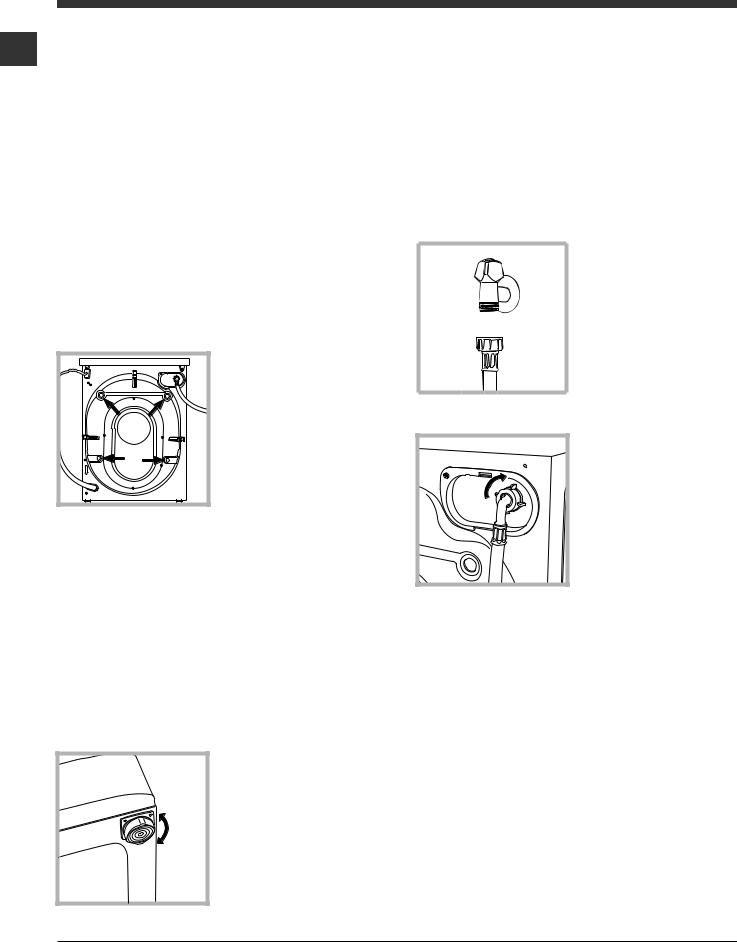
Instalación
! Es importante conservar este manual para ES poder consultarlo en cualquier momento. En caso de venta, de cesión o de traslado, verifique que permanezca junto con la lavadora
para informar al nuevo propietario sobre el funcionamiento y brindar las correspondientes advertencias.
! Lea atentamente las instrucciones: ellas contienen importante información sobre la instalación, el uso y la seguridad.
Desembalaje y nivelación
Desembalaje
1.Desembale la lavadora.
2.Controle que la lavadora no haya sufrido daños durante el transporte. Si estuviera dañada no la conecte y llame al revendedor.
3. Quite los 4 tornillos de protección para el transporte y la arandela de goma con
el correspondiente distanciador ubicados en la parte posterior (ver la figura).
4.Cubra los orificios con los tapones de plástico suministrados con el aparato.
5.Conserve todas las piezas: cuando la lavadora deba ser transportada nuevamente, deberán volver a colocarse.
! Los embalajes no son juguetes para los niños.
Nivelación
1. Instale la lavadora sobre un piso plano y rígido, sin apoyarla en las paredes, muebles ni en ningún otro aparato.
2. Si el piso no está perfectamente horizontal, compense las irregularidades desenroscando o enroscando las patas delanteras (ver la figura); el ángulo de inclinación medido sobre la superficie de trabajo, no debe superar los 2º.
Una cuidadosa nivelación brinda estabilidad a la máquina y evita vibraciones, ruidos y desplazamientos durante el funcionamiento. Cuando se instala sobre moquetas o alfom-
bras, regule los pies para conservar debajo de la lavadora un espacio suficiente para la ventilación.
Conexiones hidráulicas y eléctricas
Conexión del tubo de alimentación de agua
1. Conectar el tubo de tubo enroscándolo a un grifo de agua fría con la boca roscada de 3/4 gas (ver la figura).
Antes de conectarlo, haga correr el agua hasta que esté límpida.
2. Conecte el tubo de alimentación a la lavadora enroscándolo en la toma de agua correspondiente ubicada en la parte posterior derecha (arriba) (ver la figura).
3. Controle que en el tubo no hayan pliegues ni estrangulaciones.
! La presión de agua del grifo debe estar comprendida dentro de los valores contenidos en la tabla de Datos técnicos (ver la página correspondiente).
!Si la longitud del tubo de alimentación no es la suficiente, diríjase a un negocio especializado o a un técnico autorizado.
!No utilice nunca tubos ya usados.
!Utilice los suministrados con la máquina.
14

Conexión del tubo de descarga
65 - 100 cm |
Conecte el tubo de descarga, sin plegarlo, a una tubería de descarga o a una descarga de pared colocadas a una altura del piso entre 65 y 100 cm;
o apóyelo en el borde de un lavamanos o de una bañera, uniendo la guía suministrada con el aparato, al grifo (ver la figura). El extremo libre del tubo de descarga no debe permanecer sumergido en el agua.
! No se aconseja utilizar tubos de prolongación, si fuera indispensable hacerlo, la prolongación debe tener el mismo diámetro del tubo original y no superar los 150 cm.
Conexión eléctrica
Antes de enchufar el aparato, verifique que:
•la toma tenga la conexión a tierra y haya sido hecha según las normas legales;
•latomaseacapazdesoportarlacargamáxima de potencia de la máquina indicada en la tabla de Datos técnicos (ver al costado);
•la tensión de alimentación esté comprendida dentro de los valores indicados en la tabla de Datos técnicos (ver al costado);
•latomaseacompatibleconelenchufedelalavadora. Si no es así, sustituya la toma o el enchufe.
!La lavadora no debe ser instalada al aire libre, ni siquiera si el lugar está reparado, ya que es muy peligroso dejarla expuesta a la lluvia o a las tormentas.
!Una vez instalada la lavadora, la toma de corriente debe ser fácilmente accesible.
!No utilice prolongaciones ni conexiones múltiples.
!El cable no debe estar plegado ni sufrir compresiones.
!El cable de alimentación debe ser sustituido sólo por técnicos autorizados.
¡Atención! La empresa fabricante declina toda responsabilidad en caso de que estas normas ES no sean respetadas.
Primer ciclo de lavado
Después de la instalación y antes del uso, realice un ciclo de lavado con detergente y sin ropa, seleccionando el programa “Auto Limpieza” (ver “Limpiar la lavasecadora”).
Datos técnicos
Modelo |
EWDE 71280 |
|
|
|
|
Dimensio- |
ancho 59,5 cm. |
|
altura 85 cm. |
||
nes |
||
profundidad 53,5 cm. |
||
|
||
|
|
|
Capacidad |
de 1 a 7 kg para el lavado |
|
de 1 a 5 kg para el secado. |
||
|
||
|
|
|
Conexiones |
ver la placa de característi- |
|
cas técnicas aplicada en la |
||
eléctricas |
||
máquina |
||
|
||
|
|
|
|
presión máxima 1 MPa (10 bar) |
|
Conexiones |
presión mínima 0,05 MPa |
|
hídricas |
(0,5 bar) |
|
|
capacidad del cesto 58 litros |
|
|
|
|
Velocidad |
máxima 1200 r.p.m. |
|
de centrifu- |
||
gado |
|
|
|
|
|
|
Lavado: programa 10; |
|
|
temperatura 60ºC; efectua- |
|
Programas |
do con 7 kg. de carga. |
|
de control |
Secado: seleccionar el |
|
según la |
programa de lavado 10 y el |
|
reglamentos |
nivel de secado “A4” para |
|
EN 50229 |
ambas cargas. El primer |
|
|
secado se debe efectuar |
|
|
con la carga manual.. |
Esta máquina cumple con lo establecido por las siguientes Directivas de la Comunidad:
-EMC 2014/30/EU (Compatibilidad Electromagnética)
-2012/19/EU - (WEEE)
- LVD 2014/35/EU (Baja Tensión)
15
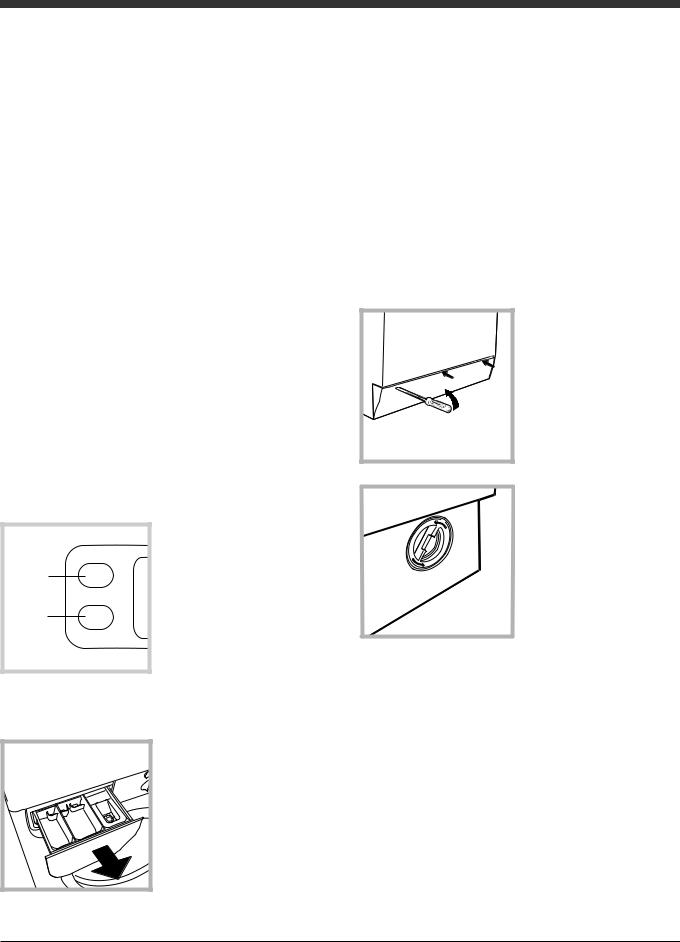
Mantenimiento y cuidados
|
Interrumpir el agua y la corriente |
|
ES |
||
eléctrica |
||
|
||
|
• Cierre el grifo de agua después de cada |
|
|
lavado. De este modo se limita el desgaste |
|
|
de la instalación hidráulica de la lavadora y |
|
|
se elimina el peligro de pérdidas. |
|
|
• Desenchufe la máquina cuando la debe lim- |
|
|
piar y durante los trabajos de mantenimiento. |
|
|
Limpiar la lavasecadora |
•La parte externa y las partes de goma se pueden limpiar con un paño embebido en agua tibia y jabón. No use solventes ni productos abrasivos.
•La lavasecadora posee un programa de “Auto
Limpieza” de su interior que se debe realizar sin
ningún tipo de carga en el cesto.
El detergente (en un 10% de la cantidad aconsejada para prendas poco sucias) o algunos aditivos específicos para la limpieza de la ropa se podrán utilizar como coadyuvantes en el programa de lavado. Se aconseja efectuar el programa de limpieza cada 40 ciclos de lavado. Para activar el programa pulse simultáneamente los botones A y B durante 5 segundos (ver la figura). El programa comenzará automáticamente y tendrá una duración de 70 minutos aproximadamente.
A
B
Limpiar el contenedor de detergentes
Extraiga el contenedor levantándolo y tirándolo hacia fuera (ver la figura).
Lávelo debajo del agua corriente, esta limpieza se debe realizar frecuentemente.
Cuidar la puerta y el cesto
•Deje siempre semicerrada la puerta para evitar que se formen malos olores.
Limpiar la bomba
La lavadora posee una bomba autolimpiante que no necesita mantenimiento. Pero puede suceder que objetos pequeños (monedas, botones) caigan en la precámara que protege la bomba, situada en la parte inferior de la misma. ! Verifique que el ciclo de lavado haya terminado y desenchufe la máquina.
Para acceder a la precámara:
1. quite el panel que cubre la parte delantera de la lavadora con la ayuda de un destornillador (ver la figura);
2. desenrosque la tapa girándola en sentido antihorario (ver la figura): es normal que se vuelque un poco de agua;
3.limpie con cuidado el interior;
4.vuelva a enroscar la tapa;
5.vuelva a montar el panel verificando, antes de empujarlo hacia la máquina, que los ganchos se hayan introducido en las correspondientes ranuras.
Controlar el tubo de alimentación de agua
Controle el tubo de alimentación al menos una vez al año. Si presenta grietas o rajaduras debe ser sustituido: durante los lavados, las fuertes presiones podrían provocar roturas imprevistas.
! No utilice nunca tubos ya usados.
16

Precauciones y consejos
! La lavasecadora fue proyectada y fabricada en conformidad con las normas internacionales de seguridad. Estas advertencias se suministran por razones de seguridad y deben ser leídas atentamente.
Seguridad general
•Este aparato ha sido fabricado para un uso de tipo doméstico exclusivamente.
•Este aparato puede ser utilizado por niños de
8 años o más y por personas con capacidades físicas, sensoriales o mentales disminuidas o con experiencia y conocimientos insuficientes siempre que sean supervisados o que hayan recibido una adecuada formación sobre el uso del aparato en forma segura y conozcan los peligros derivados del mismo. Los niños no deben jugar con el aparato. El mantenimiento y la limpieza no deben ser realizados por niños sin supervisión.
-No secar prendas no lavadas.
-Las prendas sucias con sustancias como aceite de cocina acetona, alcohol, gasolina, kerosén, quitamanchas, trementina, cera o sustancias para quitarlas, deben lavarse con agua caliente con una cantidad mayor de detergente antes de secarlas en la secadora.
-Objetos como la goma expandida (látex), las gorras de ducha, los materiales textiles impermeables, los artículos con un lado de goma y las prendas o cojines que tienen partes de látex no deben secarse en la secadora.
-Suavizantes o productos similares deben emplearse de acuerdo con las instrucciones del fabricante.
-La parte final de un ciclo de la secadora se realiza sin calor (ciclo de enfriamiento) para garantizar que los artículos no se dañen. ATENCIÓN: Nunca detener una secadora antes que finalice el programa de secado. En este caso, sacar con rapidez todas las prendas y colgarlas para enfriarlas con celeridad.
•No toque la máquina con los pies desnudos ni con las manos o los pies mojados o húmedos.
•No desenchufe la máquina tirando el cable, sino tomando el enchufe.
•No toque el agua de descarga porque puede alcanzar temperaturas elevadas.
•Nunca fuerce la puerta: podría dañarse el mecanismo de seguridad que la protege de aperturas accidentales.
• En caso de avería, no acceda nunca a los mecanismos |
ES |
internos para intentar una reparación. |
•Controle siempre que los niños no se acerquen a la máquina cuando está en funcionamiento.
•Si debe ser trasladada, deberán intervenir dos o más personas, procediendo con el máximo cuidado. La máquina no debe ser desplazada nunca por una sola persona ya que es muy pesada.
•Antes de introducir la ropa controle que el cesto esté vacío.
•Durante el secado la puerta tiende a calentarse.
•No seque ropa lavada con solventes
inflamables (por ej. tricloroetileno).
•No seque gomaespuma o elastómeros análogos.
•Verifique que, durante las fases de secado, el grifo de
agua esté abierto.
•Los niños de edad inferior a 3 años deben mantenerse alejados de la secadora en au sencia de vigilancia constante.
•Vaciar los bolsillos de todos los objetos, como encende dores o fósforos.
Eliminaciones
•Eliminación del material de embalaje: respete las normas locales, de ese modo, los embalajes podrán volver a ser utilizados.
•En base a la Norma europea 2012/19/EU - WEEE de
Residuos de aparatos Eléctricos y Electrónicos, los electrodomésticos viejos no pueden ser arrojados en los contenedores municipales habituales; tienen que ser recogidos selectivamente para optimizar la recuperación y reciclado de los componentes y materiales que los constituyen, y reducir el impacto en la salud humana y el medioambiente. El símbolo del cubo de basura tachado se marca sobre todos los productos para recordar al consumidor la obligación de separarlos para la recogida selectiva.
El consumidor debe contactar con la autoridad local o con el vendedor para informarse en relación a la correcta eleminación de su electrodoméstico viejo.
17
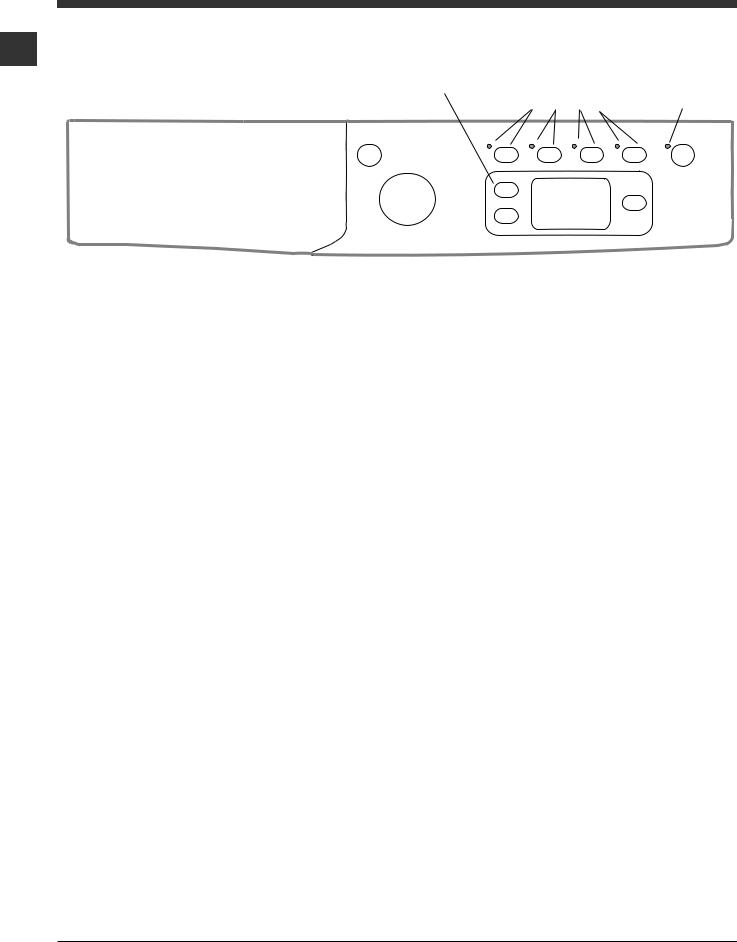
Descripción de la lavasecadora
ES |
Panel de control |
|
|
|
Botón |
Botón con |
|
Botón de ON/OFF |
|
piloto START/ |
||
|
||||
|
TEMPERATURA Botones con pilotos |
PAUSE |
||
|
|
FUNCIÓN |
|
|
|
|
|
|
|
PANTALLA
|
|
|
|
|
|
|
Botón |
|
|
|
|
|
|
|
|
Contenedor de |
|
|
|
|
|
||
|
|
Botón |
|
SECADO |
|||
detergentes |
Mando de |
|
CENTRIFUGADO |
|
|||
|
|
||||||
|
|
|
|||||
|
|
|
|
|
|||
|
|
|
|
|
|
||
|
|
PROGRAMAS |
|
|
|
|
|
|
|
|
|
|
|||
Contenedor de detergentes: para cargar detergentes y aditivos (ver “Detergentes y ropa”).
Botón ON/OFF  : presione brevemente el botón para encender o apagar la máquina. El piloto START/PAUSE que centellea lentamente de color verde indica que la máquina está encendida. Para apagar la lavasecadora durante el lavado, es necesario mantener presionado el botón durante más tiempo, aproximadamente 2 seg.; si se presiona en forma más breve o accidental, la máquina no se apagará. Si la máquina se apaga durante un lavado en curso, dicho lavado se anulará.
: presione brevemente el botón para encender o apagar la máquina. El piloto START/PAUSE que centellea lentamente de color verde indica que la máquina está encendida. Para apagar la lavasecadora durante el lavado, es necesario mantener presionado el botón durante más tiempo, aproximadamente 2 seg.; si se presiona en forma más breve o accidental, la máquina no se apagará. Si la máquina se apaga durante un lavado en curso, dicho lavado se anulará.
Mando de PROGRAMAS: para elegir los programas. Durante el funcionamiento del programa el mando no se mueve.
Botones con pilotos de FUNCIÓN: para seleccionar las funciones disponibles. El piloto correspondiente a la función seleccionada permanecerá encendido.
Botón CENTRIFUGADO  : presiónelo para disminuir o excluir totalmente el centrifugado - el valor se indica en la pantalla.
: presiónelo para disminuir o excluir totalmente el centrifugado - el valor se indica en la pantalla.
Botón TEMPERATURA  : presiónelo para disminuir o excluir la temperatura; el valor se indica en la pantalla.
: presiónelo para disminuir o excluir la temperatura; el valor se indica en la pantalla.
Botón SECADO  : presionar para reducir o excluir el secado; el nivel o el tiempo de secado seleccionado se indica en el visor (ver “Cómo efectuar un ciclo de lavado o de secado”).
: presionar para reducir o excluir el secado; el nivel o el tiempo de secado seleccionado se indica en el visor (ver “Cómo efectuar un ciclo de lavado o de secado”).
Botón con piloto START/PAUSE 
 : cuando el piloto verde centellea lentamente, presione el botón para que comience el lavado. Una vez que el ciclo ha comenzado, el piloto se mantiene fijo. Para poner en pausa el lavado, presione nuevamente el botón; el piloto centelleará con un color anaranjado. Si el símbolo
: cuando el piloto verde centellea lentamente, presione el botón para que comience el lavado. Una vez que el ciclo ha comenzado, el piloto se mantiene fijo. Para poner en pausa el lavado, presione nuevamente el botón; el piloto centelleará con un color anaranjado. Si el símbolo  no está iluminado, se podrá abrir la puerta (espere 3 minutos aproximadamente). Para que el lavado se reanude a partir del momento en el cual fue interrumpido, presione nuevamente el botón.
no está iluminado, se podrá abrir la puerta (espere 3 minutos aproximadamente). Para que el lavado se reanude a partir del momento en el cual fue interrumpido, presione nuevamente el botón.
Modalidad de stand by
Esta lavasecadora está en conformidad con las nuevas normativas vinculadas al ahorro energético. Está dotada de un sistema de auto-apagado (stand by) que, en caso de no funcionamiento, se activa pasados aproximadamente 30 minutos. Presionar brevemente el botón ON-OFF y esperar que la máquina se active.
Consumo en off-mode: 0,5 W Consumo en Left-on: 8 W
18

Pantalla |
ES |
|
B
A C
La pantalla es útil para programar la máquina y brinda múltiple información.
En la sección A se visualiza la duración de los distintos programas a disposición y, para los que han comenzado, el tiempo que falta para su finalización; si se hubiera seleccionado un COMIENZO RETRASADO, se visualiza el tiempo que falta para que comience el programa seleccionado. Además, presionando el botón correspondiente, se visualizan los valores máximos de temperatura, de velocidad de centrifugado y del nivel o del tiempo de secado que la máquina puede alcanzar en base al programa seleccionado.
En la sección B se visualizan las fases previstas para el ciclo seleccionado y, una vez comenzado el programa, la fase de lavado y eventualmente de secado en curso:
 Lavado
Lavado
 Aclarado
Aclarado

 Centrifugado/Descarga
Centrifugado/Descarga  Secado
Secado
En la sección C se encuentran, de arriba hacia abajo, los íconos correspondientes a la “temperatura” , al “Secado” |
y al |
|
“centrifugado” : |
|
|
El símbolo |
iluminado indica que en la pantalla se visualiza el valor seleccionado de “temperatura”. |
|
El símbolo |
se ilumina durante la regulación del secado. |
|
El símbolo |
iluminado indica que en la pantalla se visualiza el valor seleccionado de “centrifugado”. |
|
Símbolo Puerta bloqueada 
El símbolo encendido indica que la puerta está bloqueada. Para evitar daños, se debe esperar que el símbolo se apague, antes de abrir la puerta (espere 3 minutos aproximadamente).
Para abrir la puerta mientras un ciclo está en curso, presione el botón START/PAUSE; si el símbolo PUERTA BLOQUEADA  está apagado, será posible abrir la puerta (espere 3 minutos aproximadamente).
está apagado, será posible abrir la puerta (espere 3 minutos aproximadamente).
19

Cómo efectuar un ciclo de lavado o de secado
ES |
1. ENCENDER LA MÁQUINA. Presione el botón |
|
; el |
|
|||
|
|||
piloto START/PAUSE centelleará lentamente de color |
|||
verde.
2.CARGAR LA ROPA. Abra la puerta. Cargue la ropa, cuidando no superar la cantidad de carga indicada en la tabla de programas de la página siguiente.
3.DOSIFICAR EL DETERGENTE.Extraiga el contenedor y vierta el detergente en las cubetas correspondientes como se explica en “Detergentes y ropa”.
4.CERRAR LA PUERTA.
5.ELEGIR EL PROGRAMA. Seleccione el programa deseado con el mando de PROGRAMAS; a dicho programa se le asociará una temperatura y una velocidad de centrifugado que se pueden modificar. En la pantalla aparecerá la duración del ciclo.
6.PERSONALIZAR EL CICLO DE LAVADO. Utilice los botones correspondientes:

 Modificar la temperatura y/o el centrifugado.
Modificar la temperatura y/o el centrifugado.
La máquina muestra automáticamente la temperatura y la centrífuga máximas previstas para el programa fijado o las últimas seleccionadas si son compatibles con el programa elegido. Presionando el botón se disminuye progresivamente la temperatura hasta llegar al lavado en frío “OFF”. Presionando el botón  se disminuye progresivamente el centrifugado hasta su exclusión “OFF”. Si se presionan una vez más los botones, se volverá a los valores máximos previstos.
se disminuye progresivamente el centrifugado hasta su exclusión “OFF”. Si se presionan una vez más los botones, se volverá a los valores máximos previstos.
! Excepción: cuando se selecciona el programa 2, la temperatura se puede aumentar hasta 60°.
 Programar el secado. Con la primera presión del botón
Programar el secado. Con la primera presión del botón  la máquina selecciona automáticamente el nivel de secado máximo compatible con el programa seleccionado. Las siguientes presiones disminuyen el nivel y el tiempo de secado hasta llegar a la exclusión “OFF”. Si se presionan una vez más los botones, se volverá a los valores máximos previstos.
la máquina selecciona automáticamente el nivel de secado máximo compatible con el programa seleccionado. Las siguientes presiones disminuyen el nivel y el tiempo de secado hasta llegar a la exclusión “OFF”. Si se presionan una vez más los botones, se volverá a los valores máximos previstos.
Es posible programar el secado:
A - En función del nivel de secado deseado:
Planchar (A1): especial para prendas que después deben plancharse. El nivel de humedad residual atenúa las arrugas y facilita su eliminación.
Colgar (A2): ideal para aquellas prendas que no requieren el secado completo.
Doblar (A3): se adapta para la ropa que se coloca en el armario sin necesidad de planchar.
Extra (A4): especial para las prendas que necesitan un secado completo como toallas o albornoces. B - En base al tiempo: de 30 a 180 minutos.
Si excepcionalmente la carga de ropa para lavar y secar es superior al máximo previsto (ver la Tabla de programas), realice el lavado, y una vez finalizado el programa, divida la carga y coloque una parte en el cesto. A partir de ese momento, siga las instrucciones para efectuar “Sólo el secado”.
Repita las mismas operaciones para la carga restante. Al finalizar el secado continúa siempre un período de enfriamiento.
Sólo el secado
Seleccionar con el mando de programas el secado adecuado (15-16) al tipo de tejido. Se puede programar también el nivel o el tiempo de secado deseado utilizando el botón SECADO  .
.
Modificar las características del ciclo.
•Presione el botón para activar la función; el piloto correspondiente al botón se encenderá.
•Presione nuevamente el botón para desactivar la función; el piloto se apagará.
!Si la función seleccionada no es compatible con el programa elegido, el piloto centelleará y la función no se activará.
!Si la función elegida no es compatible con otra seleccionada precedentemente, el piloto correspondiente a la primera función seleccionada centelleará y se activará sólo la segunda, el piloto de la función activada se iluminará.
!Las funciones pueden variar la carga recomendada y/o la duración del ciclo.
7.PONER EN MARCHA EL PROGRAMA. Presione el botón START/PAUSE. El piloto correspondiente se iluminará de color verde fijo y la puerta se bloqueará
(símbolo PUERTA BLOQUEADA  encendido). Para cambiar un programa mientras un ciclo está en curso, ponga la lavasecadora en pausa presionando el botón START/PAUSE (el piloto START/PAUSE centelleará lentamente de color anaranjado); luego seleccione el ciclo deseado y presione nuevamente el botón START/PAUSE. Para abrir la puerta mientras un ciclo está en curso, presione el botón START/PAUSE; si el símbolo PUERTA
encendido). Para cambiar un programa mientras un ciclo está en curso, ponga la lavasecadora en pausa presionando el botón START/PAUSE (el piloto START/PAUSE centelleará lentamente de color anaranjado); luego seleccione el ciclo deseado y presione nuevamente el botón START/PAUSE. Para abrir la puerta mientras un ciclo está en curso, presione el botón START/PAUSE; si el símbolo PUERTA
BLOQUEADA  está apagado, será posible abrir la puerta (espere 3 minutos aproximadamente). Presione nuevamente el botón START/PAUSE para reanudar el programa a partir del momento en el que se había interrumpido.
está apagado, será posible abrir la puerta (espere 3 minutos aproximadamente). Presione nuevamente el botón START/PAUSE para reanudar el programa a partir del momento en el que se había interrumpido.
8.FIN DEL PROGRAMA. En la pantalla aparecerá el mensaje “END”, cuando el símbolo PUERTA BLOQUEADA
 se apague, será posible abrir la puerta (espere 3 minutos aproximadamente). Abra la puerta, descargue la ropa y apague la máquina.
se apague, será posible abrir la puerta (espere 3 minutos aproximadamente). Abra la puerta, descargue la ropa y apague la máquina.
! Si desea anular un ciclo que ya ha comenzado, presione más tiempo el botón  . El ciclo se interrumpirá y la máquina se apagará.
. El ciclo se interrumpirá y la máquina se apagará.
20
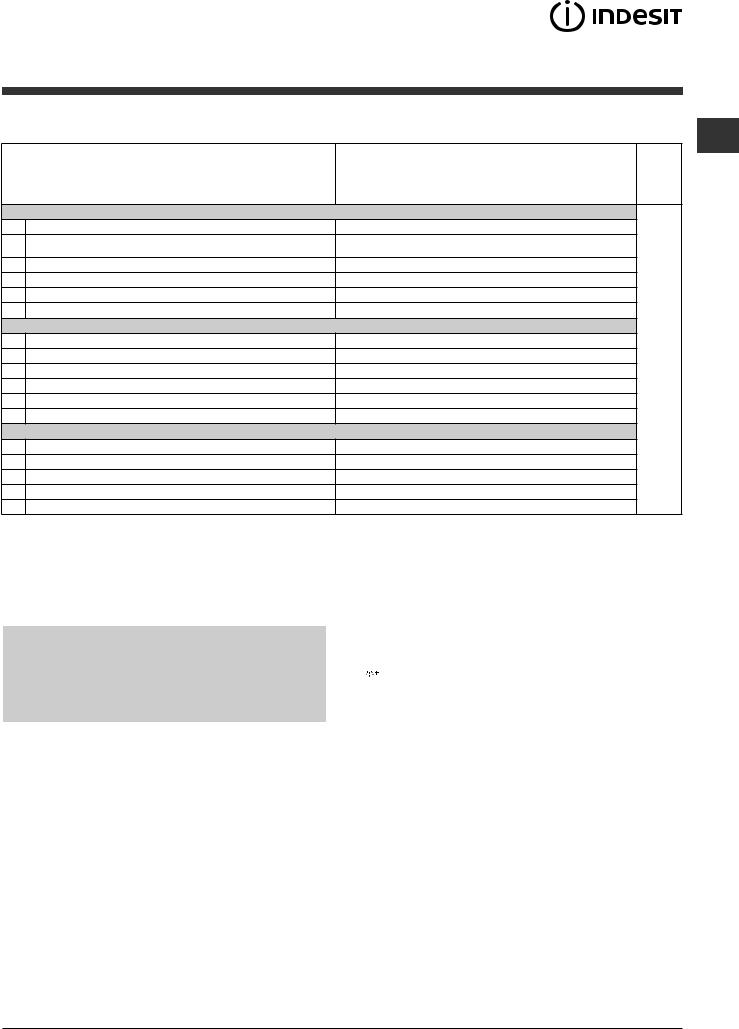
Programas y funciones
Tabla de programas
Programas |
Descripción del Programa |
|
|
|
EVERYDAY FAST |
|
1Mezcla de tejidos de color 59’
2Sintéticos 59’
3Algodón 45’
4Lava y Seca 90’
5Lava y Seca 45’
6AirFresh 30’
Special
7Lana: para lana, cachemira, etc.
8Delicados
9Ropa deportiva
10Eco Algodón (1): blancos y colores resistentes muy sucios.
10Eco Algodón (2): blancos y colores delicados muy sucios.
11Algodón: blancos sumamente sucios.
Partial
12Aclarado
13Centrifugado
14Descarga
15Algodón
16Sintético
Temp. |
Velocidad |
|
|
Detergentes |
Carga |
||
max. |
Secado |
|
|
|
|
máx. |
|
máx. (r.p.m.) |
|
|
|
|
|||
|
|
|
Suavi- |
||||
(°C) |
|
|
|
Lavado |
|
(Kg.) |
|
|
|
|
|
|
zante |
|
|
|
|
|
|
|
|
|
|
40° |
|
|
|
|
|
|
|
1000 |
|
|
7 |
||||
40° |
1000 |
|
|
|
|
|
4,5 |
(Max. 60°) |
|
|
|||||
|
|
|
|
|
|
|
|
40° |
1200 |
|
|
|
|
|
3,5 |
30° |
1200 |
|
|
|
|
|
2 |
30° |
1200 |
|
|
|
|
|
1 |
- |
- |
|
|
- |
|
- |
1,5 |
40° |
|
|
|
|
|
|
|
800 |
|
|
2 |
||||
30° |
0 |
|
|
|
|
|
1 |
40° |
600 |
|
|
|
|
|
3,5 |
60° |
1200 |
|
|
|
|
|
7 |
40° |
1200 |
|
|
|
|
|
7 |
90° |
1200 |
|
|
|
|
|
7 |
- |
|
|
|
|
|
|
|
1200 |
|
- |
|
7 |
|||
- |
1200 |
|
|
- |
|
- |
7 |
- |
0 |
- |
|
- |
|
- |
7 |
- |
- |
|
|
- |
|
- |
5 |
- |
- |
|
|
- |
|
- |
4 |
ES
Duración del ciclo
la en lavado de programas los de duración la controlar puede Se .pantalla
La duración del ciclo que se indica en el visor o en el manual es una estimación calculada en base a condiciones estándar. El tiempo efectivo puede variar en función de numerosos factores como la temperatura y la presión del agua de entrada, la temperatura ambiente, la cantidad de detergente, la cantidad y el tipo de carga, el equilibrado de la carga y las opciones adicionales seleccionadas.
Para todos los Test Institutes:
1)Programa de control según la reglamentos EN 50229: seleccione el programa 10 con una temperatura de 60ºC.
2)Programa algodón largo: seleccione el programa 10 con una temperatura de 40ºC.
Funciones de lavado
-Si la función seleccionada no es compatible con el programa elegido, el piloto centelleará y la función no se activará.
-Si la función elegida no es compatible con otra seleccionada precedentemente, el piloto correspondiente a la primera función seleccionada centelleará y se activará
sólo la segunda, el piloto de la función activada se iluminará.
ExtraWash 
Para prendas muy sucias, activar la opción Extra Wash 
, si es compatible. Si se selecciona esta opción, el ciclo readapta automáticamente todos los parámetros de lavado pasando a un ciclo de mayor duración. La opción mantiene inalterada la temperatura, mientras que el centrifugado se pone automáticamente al máximo. El usuario puede restablecer el centrifugado en el valor deseado.
 Plancha fácil
Plancha fácil
Cuando se selecciona esta función, el lavado y el centrifugado se modificarán oportunamente para disminuir la formación de arrugas. Al finalizar el ciclo, la lavasecadora realizará lentas rotaciones del cesto; el piloto de la función PLANCHA FÁCIL y el de START/PAUSE centellarán (el primero verde, el segundo anaranjado). Para finalizar el ciclo se deberá presionar el botón START/PAUSE o el botón PLANCHA FÁCIL.
Note: si desea realizar también el secado, este botón funciona sólo conjuntamente con el nivel “A1” (Planchar).
 Aclarado extra
Aclarado extra
Al elegir esta función aumentará la eficacia del aclarado y se asegurará la máxima eliminación del detergente. Es útil para pieles particularmente sensibles.
 Comienzo retrasado
Comienzo retrasado
Para seleccionar el comienzo retrasado del programa elegido, presione el botón correspondiente hasta alcanzar el tiempo de retraso deseado. Cuando esta opción se activa, la luz testigo respectiva permanece encendida. Para cancelar el comienzo retrasado presionar el botón hasta que en el display aparezca “OFF”.
21
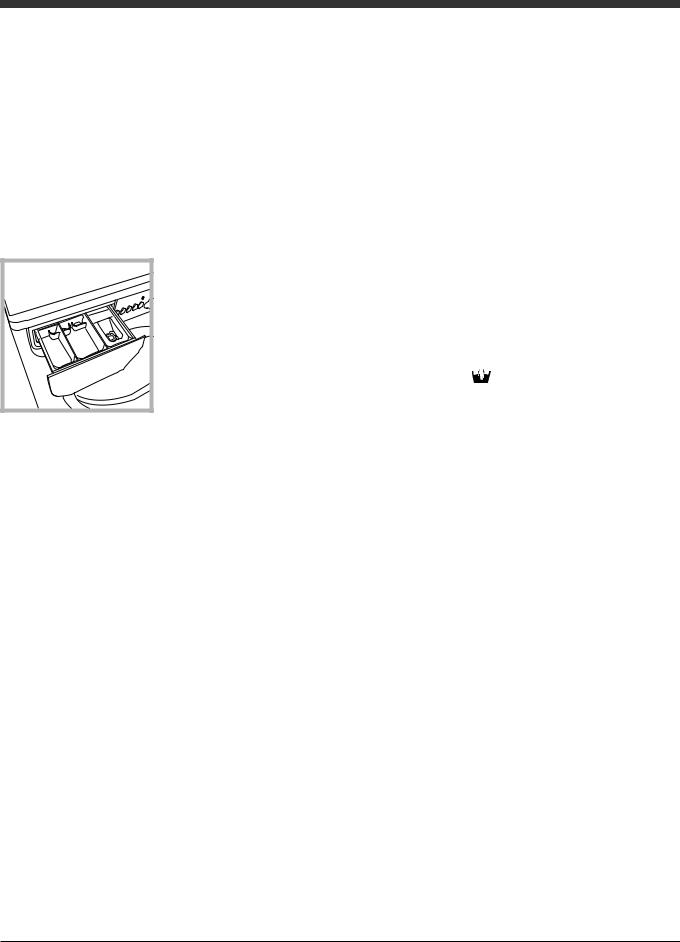
Detergentes y ropa
|
Contenedor de detergentes |
|
ES |
||
El buen resultado del lavado depende también de la cor- |
||
|
||
|
||
|
recta dosificación del detergente: si se excede la cantidad, |
|
|
no se lava de manera más eficaz, sino que se contribuye a |
|
|
encostrar las partes internas de la lavasecadora y a conta- |
|
|
minar el medio ambiente. |
|
|
! No use detergentes para el lavado a mano porque pro- |
|
|
ducen demasiada espuma. |
|
|
! Utilice detergentes en polvo para prendas de algodón |
|
|
blancas, para el prelavado y para lavados con una tempe- |
|
|
ratura mayor que 60ºC. |
|
|
! Respete las indicaciones que se encuentran en el envase |
|
|
de detergente. |
1 |
2 |
3 |
Extraiga el contenedor de detergentes e introduzca el detergente o el aditivo de la siguiente manera:
!No ponga el detergente en el cubeta 1.
!El detergente debe ser puesta sólo en el cubeta 2. cubeta 2: Detergente para lavado (en polvo o líquido)
El detergente líquido se debe verter sólo antes de la puesta en marcha.
cubeta 3: Aditivos (suavizante, etc.)
El suavizante no se debe volcar fuera de la rejilla.
Nota: En caso de uso de “detergente en pastillas”, atenerse siempre a las indicaciones del fabricante.
Preparar la ropa
•Subdivida la ropa según:
-el tipo de tejido / el símbolo en la etiqueta.
-los colores: separe las prendas de color y las blancas.
•Vacíe los bolsillos y controle los botones.
•No supere los valores indicados en la “Tabla de Programas” referidos al peso de la ropa seca.
¿Cuánto pesa la ropa?
1 sábana 400/500 g
1 funda 150/200 g
1 mantel 400/500 g
1 albornoz 900/1200 g
1 toalla 150/250 g
Ciclos diarios rápidos
Un conjunto completo de programas rápidos para lavar los tejidos más comunes, incluso con carga completa, y eliminar la suciedad cotidiana más frecuente en menos de 1 hora.
Mezcla de tejidos de color 59’: para lavar prendas mixtas y coloreadas juntas.
Sintéticos 59’: específico para lavar prendas sintéticas. En caso de suciedad resistente, es posible aumentar la temperatura a 60° y utilizar detergente en polvo.
Algodón 45’: ciclo breve diseñado para lavar prendas de algodón delicadas.
Programas particulares
Lava y Seca 90’: el ciclo garantiza las prestaciones de lavado y secado con una carga de 2kg en 90’ “A1” (Planchar); en caso de cargas superiores, la duración del ciclo aumenta con el fin de asegurar las mismas prestaciones.
Lava y Seca 45’: utilice este programa para lavar y secar prendas (Algodón y Sintéticos) ligeramente sucias en poco tiempo Seleccionando este ciclo se puede lavar y secar hasta 1 kg de ropa en sólo 45 minutos “A1” (Planchar). Para alcanzar los mejores resultados utilizar detergente líquido; pre-tratar puños, cuellos y manchas.
AirFresh 30’ (programma 6) ciclo ideal para refrescar y eliminar los malos olores, especialmente de humo, de las prendas de algodón y sintéticas (máx. 1,5kg) en sólo 30 minutos, sin fase de lavado.
Lana: con el programa 7 es posible lavar en la lavasecadora todas las prendas de lana, aún las que contienen la etiqueta “sólo lavado a mano”  Para obtener los mejores resultados utilice un detergente específico y no supere 2 Kg. de ropa. Delicados: utilice el programa 8 para el lavado de prendas muy delicadas. Se aconseja dar la vuelta a las prendas antes del lavado. Para obtener mejores resultados, se recomienda el uso de detergente líquido para prendas delicadas.
Para obtener los mejores resultados utilice un detergente específico y no supere 2 Kg. de ropa. Delicados: utilice el programa 8 para el lavado de prendas muy delicadas. Se aconseja dar la vuelta a las prendas antes del lavado. Para obtener mejores resultados, se recomienda el uso de detergente líquido para prendas delicadas.
Para el lavado de las prendas de Seda y Cortinas, seleccione el ciclo 8 y active la opción “PLANCHA FÁCIL”; a máquina terminará el ciclo dejando la ropa en remojo y el piloto
“PLANCHA FÁCIL” centelleará. Para descargar el agua y poder sacar la ropa, es necesario presionar el botón START/
PAUSE o el botón “PLANCHA FÁCIL”.
Seleccionando la función de secado exclusivamente con tiempo, al finalizar el lavado se realizará un secado de particular delicadeza gracias a un movimiento suave y a un chorro de aire con temperatura controlada.
Los tiempos aconsejados son: 1 kg de sintético --> 150 min.
1 kg de sintético y algodón --> 180 min. 1 kg de algodón --> 180 min.
El grado de secado dependerá de la carga y de la composición del tejido.
Ropa deportiva: ciclo adecuado para lavar todas las prendas deportivas juntas, incluida la toalla del gimnasio, respetando las fibras (atenerse a las indicaciones de las etiquetas de las prendas).
Sistema de equilibrado de la carga
Antes de cada centrifugado, para evitar vibraciones excesivas y para distribuir la carga de modo uniforme, el cesto realiza rotaciones a una velocidad ligeramente superior a la del lavado. Si después de varios intentos, la carga todavía no está correctamente equilibrada, la máquina realiza el centrifugado a una velocidad inferior a la prevista. Cuando existe un excesivo desequilibrio, la lavasecadora realiza la distribución antes que el centrifugado. Para obtener una mejor distribución de la carga y su correcto equilibrado, se
aconseja mezclar prendas grandes y pequeñas.
22

Anomalías y soluciones
|
|
|
|
Puede suceder que la lavasecadora no funcione. Antes de llamar al Servicio de Asistencia Técnica (ver “Asistencia”),controle |
|
||
ES |
|||
que no se trate de un problema de fácil solución utilizando la siguiente lista. |
|||
|
|||
|
|
|
|
Anomalías:
La lavasecadora no se enciende.
El ciclo de lavado no comienza.
La lavasecadora no carga agua (en la pantalla se visualizará el mensaje “H2O” centelleante).
La lavasecadora carga y descarga agua continuamente.
La lavasecadora no descarga o no centrifuga.
Posibles causas / Solución:
•El enchufe no está introducido en la toma de corriente, o no hace contacto.
•En la casa no hay corriente.
•La puerta no está correctamente cerrada.
•El botón ON/OFF no ha sido presionado.
•El botón START/PAUSE no ha sido presionado.
•El grifo de agua no está abierto.
•Se fijó un retraso de la hora de puesta en marcha.
•El tubo de alimentación de agua no está conectado al grifo.
•El tubo está plegado.
•El grifo de agua no está abierto.
•En la casa no hay agua.
•No hay suficiente presión.
•El botón START/PAUSE no ha sido presionado.
•Eltubodedescarganoestáinstaladoentrelos65y100cm.delsuelo(ver “Instalación”).
•El extremo del tubo de descarga está sumergido en el agua (ver “Instalación”).
•La descarga de pared no posee un respiradero.
Si después de estas verificaciones, el problema no se resuelve, cierre el grifo de agua, apague la lavasecadora y llame a la Asistencia. Si la vivienda se encuentra en uno de los últimos pisos de un edificio, es posible que se verifiquen fenómenos de sifonaje, por ello la lavasecadora carga y descarga agua de modo continuo. Para eliminar este inconveniente se encuentran disponibles en el comercio válvulas especiales que permiten evitar el sifonaje.
•El programa no prevé la descarga: con algunos programas es necesario ponerla en marcha manualmente (“Programas y funciones”).
•Se puede utilizar la función “Plancha fácil”: para completar el programa, pulse el botón START/PAUSE (“Programas y funciones”).
•El tubo de descarga está plegado (ver “Instalación”).
•El conducto de descarga está obstruido.
La lavasecadora vibra mucho durante la centrifugación.
La lavasecadora pierde agua.
Los pilotos de las “opciones” y el piloto de “START/PAUSE” parpadean y en el display aparece un código de anomalía (Ej.: F-01, F-..).
Se forma demasiada espuma.
La Lavasecadora no seca.
•El cesto, en el momento de la instalación, no fue desbloqueado correctamente
(ver “Instalación”).
•La máquina no está instalada en un lugar plano (ver “Instalación”).
•Existemuypocoespacioentrelamáquina,losmueblesylapared(ver “Instalación”).
•El tubo de alimentación de agua no está bien enroscado (ver “Instalación”).
•El contenedor de detergentes está obstruido (para limpiarlo ver “Mantenimiento y cuidados”).
•El tubo de descarga no está bien fijado (ver “Instalación”).
•Apague la máquina y desenchúfela, espere aproximadamente 1 minuto y luego vuelva a encenderla.
Si la anomalía persiste, llame al Servicio de Asistencia Técnica.
•El detergente no es específico para la lavasecadora (debe contener algunas de las frases “para lavasecadora”, “a mano o en lavasecadora” o similares).
•La dosificación fue excesiva.
•El enchufe no está introducido en la toma de corriente, o no hace contacto.
•En la casa no hay corriente.
•La puerta no está bien cerrada.
•Se fijó un retraso de la hora de puesta en funcionamiento.
•El SECADO está en la posición OFF.
23

Asistencia
|
|
|
|
|
|
Antes de llamar al Servicio de Asistencia Técnica: |
|
ES |
|||
|
• Verifique si la anomalía la puede resolver Ud. solo (ver “Anomalías y soluciones”); |
||
|
|
||
|
|
• Vuelva a poner en marcha el programa para controlar si el inconveniente fue resuelto; |
|
|
|||
|
|
• Si no es así, llame al Servicio de Asistencia técnica autorizado, al número de teléfono indicado en el certificado de garantía. |
|
|
|
! No recurra nunca a técnicos no autorizados. |
Comunique:
•el tipo de anomalía;
•el modelo de la máquina (Mod.);
•el número de serie (S/N ).
Esta información se encuentra en la placa aplicada en la parte posterior de la lavasecadora y en la parte delantera abriendo la puerta.
La siguiente información es válida solo para España.
Para otros países de habla hispana consulte a su vendedor.
Ampliación de garantía
Llame al 902.363.539 y le informaremos sobre el fantástico plan de ampliación de garantía hasta 5 años. Consiga una cobertura total adicional de
•Piezas y componentes
•Mano de obra de los técnicos
•Desplazamiento a su domicilio de los técnicos
Y NO PAGUE AVERIAS NUNCA MAS
Servicio de asistencia técnica (SAT)
Llame al 902.133.133 y nuestros técnicos intervendrán con rapidez y eficacia, devolviendo el electrodoméstico a sus condiciones óptimas de funcionamiento.
En el SAT encontrará recambios, accesorios y productos específicos para la limpieza y mantenimiento de su electrodoméstico a precios competitivos.
ESTAMOS A SU SERVICIO
24

Návod k použití
CZ
Český
EWDE 71280
|
|
PRAČKA |
|
|
! |
Tento symbol vám připomíná potřebu |
|
||
CZ |
||||
přečtení návodu k použití. |
|
|||
|
||||
Obsah
Instalace, 26-27
Rozbalení a vyrovnání do vodorovné polohy
Připojení k elektrické a k vodovodní síti
První prací cyklus
Technické údaje
Údržba a péče, 28
Uzavření přívodu vody a vypnutí elektrického napájení Čištění pračky
Čištění dávkovače pracích prostředků Péče o dvířka a buben
Čištění čerpadla
Kontrola přítokové hadice na vodu
Opatření a rady, 29
Základní bezpečnostní pokyny
Likvidace
Popis pračky, 30-31
Ovládací panel
Displej
Jakprovéstpracícyklusnebocyklussušení,32
Programy a funkce, 33
Tabulka programů Funkce praní
Prací prostředky a prádlo, 34
Dávkovač pracích prostředků Příprava prádla Každodenní rychlé cykly Speciální programy
Systém automatického vyvážení náplně
Poruchy a způsob jejich odstranění, 35
Servisní služba, 36
25

Instalace
! Je důležité uschovat tento návod tak, aby- CZ ste jej mohli kdykoli konzultovat. V případě prodeje, darování nebo přestěhování pračky
se ujistěte, že zůstane uložen v blízkosti pračky, aby mohl posloužit novému majiteli při seznámení s její činností a s příslušnými upozorněními.
! Pozorně si přečtěte uvedené pokyny: obsahují důležité informace týkající se instalace, použití a bezpečnosti při práci.
Rozbalení a vyrovnání do vodorovné polohy
Rozbalení
1. Rozbalte pračku.
2. Zkontrolujte, zda během přepravy nedošlo k jejímu poškození. V případě, že je poškozena, ji nezapojujte a obraťte se na prodejce.
4.Uzavřete otvory po šroubech plastovými krytkami z příslušenství.
5.Uschovejte všechny díly: v případě opětovné přepravy pračky je bude třeba namontovat zpět.
! Obaly nejsou hračky pro děti!
Vyrovnání do vodorovné polohy
1. Pračku je třeba umístit na rovnou a pevnou podlahu, aniž by se opírala o stěnu, nábytek či něco jiného.
Dokonalé vyrovnání do vodorovné polohy zabezpečí stabilitu zařízení a zamezí vzniku vibrací a hluku během činnosti. V případě instalace na podlahovou krytinu nebo na koberec nastavte nožky tak, aby pod pračkou zůstal dostatečný volný prostor pro ventilaci.
Připojení k elektrické a k vodovodní síti
Připojení přítokové hadice vody
1. Připojte přívodní hadici jejím zašroubováním ke kohoutku studené vody s hrdlem se závitem 3/4“ (viz obrázek).
de čirá.
Před připojením hadice nechte vodu odtékat, dokud nebu-
2. Připojte přítokovou hadici k pračce prostřednictvím příslušné přípojky na vodu, umístěné vpravo nahoře (viz obrázek).
3. Dbejte na to, aby hadice nebyla příliš ohnutá ani stlačená.
!Tlak v rozvodu vody se musí pohybovat v rozmezí hodnot uvedených v tabulce s technickými údaji
(viz vedlejší strana).
!V případě, že délka přítokové hadice nebude dostatečná, obraťte se na specializovanou prodejnu nebo na autorizovaný technický personál.
!Nikdy nepoužívejte již použité hadice.
!Používejte hadice z příslušenství zařízení.
26
